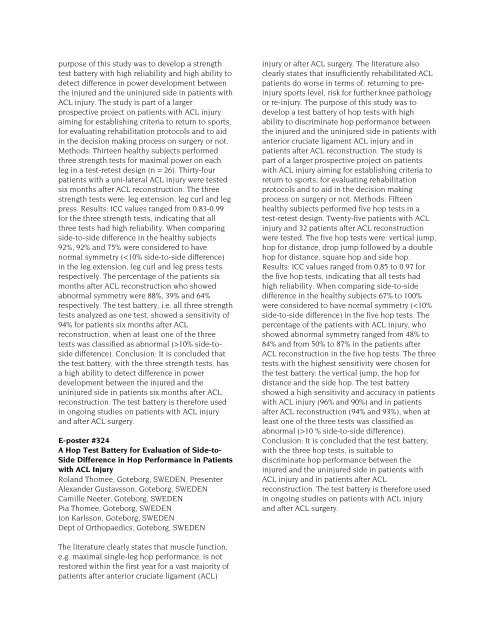POSTER ABSTRACTS - ISAKOS
POSTER ABSTRACTS - ISAKOS
POSTER ABSTRACTS - ISAKOS
Create successful ePaper yourself
Turn your PDF publications into a flip-book with our unique Google optimized e-Paper software.
purpose of this study was to develop a strength<br />
test battery with high reliability and high ability to<br />
detect difference in power development between<br />
the injured and the uninjured side in patients with<br />
ACL injury. The study is part of a larger<br />
prospective project on patients with ACL injury<br />
aiming for establishing criteria to return to sports,<br />
for evaluating rehabilitation protocols and to aid<br />
in the decision making process on surgery or not.<br />
Methods: Thirteen healthy subjects performed<br />
three strength tests for maximal power on each<br />
leg in a test-retest design (n = 26). Thirty-four<br />
patients with a uni-lateral ACL injury were tested<br />
six months after ACL reconstruction. The three<br />
strength tests were: leg extension, leg curl and leg<br />
press. Results: ICC values ranged from 0.83-0.99<br />
for the three strength tests, indicating that all<br />
three tests had high reliability. When comparing<br />
side-to-side difference in the healthy subjects<br />
92%, 92% and 75% were considered to have<br />
normal symmetry (10% side-toside<br />
difference). Conclusion: It is concluded that<br />
the test battery, with the three strength tests, has<br />
a high ability to detect difference in power<br />
development between the injured and the<br />
uninjured side in patients six months after ACL<br />
reconstruction. The test battery is therefore used<br />
in ongoing studies on patients with ACL injury<br />
and after ACL surgery.<br />
E-poster #324<br />
A Hop Test Battery for Evaluation of Side-to-<br />
Side Difference in Hop Performance in Patients<br />
with ACL Injury<br />
Roland Thomee, Goteborg, SWEDEN, Presenter<br />
Alexander Gustavsson, Goteborg, SWEDEN<br />
Camille Neeter, Goteborg, SWEDEN<br />
Pia Thomee, Goteborg, SWEDEN<br />
Jon Karlsson, Goteborg, SWEDEN<br />
Dept of Orthopaedics, Goteborg, SWEDEN<br />
injury or after ACL surgery. The literature also<br />
clearly states that insufficiently rehabilitated ACL<br />
patients do worse in terms of: returning to preinjury<br />
sports level, risk for further knee pathology<br />
or re-injury. The purpose of this study was to<br />
develop a test battery of hop tests with high<br />
ability to discriminate hop performance between<br />
the injured and the uninjured side in patients with<br />
anterior cruciate ligament ACL injury and in<br />
patients after ACL reconstruction. The study is<br />
part of a larger prospective project on patients<br />
with ACL injury aiming for establishing criteria to<br />
return to sports, for evaluating rehabilitation<br />
protocols and to aid in the decision making<br />
process on surgery or not. Methods: Fifteen<br />
healthy subjects performed five hop tests in a<br />
test-retest design. Twenty-five patients with ACL<br />
injury and 32 patients after ACL reconstruction<br />
were tested. The five hop tests were: vertical jump,<br />
hop for distance, drop jump followed by a double<br />
hop for distance, square hop and side hop.<br />
Results: ICC values ranged from 0.85 to 0.97 for<br />
the five hop tests, indicating that all tests had<br />
high reliability. When comparing side-to-side<br />
difference in the healthy subjects 67% to 100%<br />
were considered to have normal symmetry (10 % side-to-side difference).<br />
Conclusion: It is concluded that the test battery,<br />
with the three hop tests, is suitable to<br />
discriminate hop performance between the<br />
injured and the uninjured side in patients with<br />
ACL injury and in patients after ACL<br />
reconstruction. The test battery is therefore used<br />
in ongoing studies on patients with ACL injury<br />
and after ACL surgery.<br />
The literature clearly states that muscle function,<br />
e.g. maximal single-leg hop performance, is not<br />
restored within the first year for a vast majority of<br />
patients after anterior cruciate ligament (ACL)
















